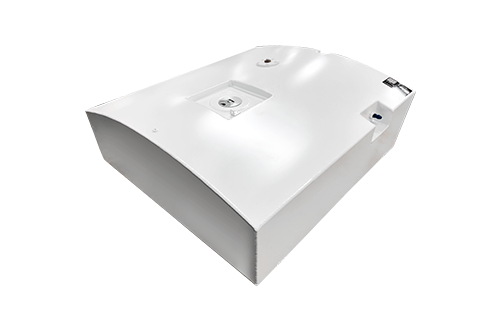Cessna 150 & 152
Constructed of heavy gauge aluminum, the tank occupies part of the baggage area, with plenty of room left over for luggage. To operate, the pilot simply turns on a switch to start fuel transfer when the right main tank is two-thirds full. An electric pump transfers fuel into the right wing at approximately 6 gallons per hour. An indicator light in the cockpit is illuminated while fuel is flowing. A mechanical gauge is mounted on top of the tank. When the tank runs empty, the pump shuts off automatically.
A flush-mounted external filler cap is installed on the right side of the aircraft, a popular feature among users of autogas. Installation requires approximately 20 man hours; empty weight 15.2 lbs.; dimensions 9" × 30" × 17".
Cessna 172
Designed to conserve valuable luggage area, the all-welded aluminum tank is installed in the aft baggage compartment, raising the floor approximately five inches above the base of the door. To operate, the pilot burns off approximately one-third of the fuel from the right main tank. By turning on a switch located near the fuel selector, transfer is initiated. An electric fuel pump transfers fuel at the rate of burn (set for your model—between 8 and 12 gallons per hour). When the auxiliary tank runs empty, the pump shuts off automatically and the light goes out. Installation requires approximately 25 man hours.
Cessna 182
Designed to conserve valuable luggage area, the all-welded aluminum tank is installed in the aft baggage compartment, raising the floor approximately five inches above the base of the door. To operate, the pilot burns off approximately one-third of the fuel from the right main tank. By turning on a switch located near the fuel selector, transfer is initiated. An electric fuel pump transfers fuel at the rate of burn (set for your model—between 8 and 12 gallons per hour). When the auxiliary tank runs empty, the pump shuts off automatically and the light goes out. Installation requires approximately 25 man hours.
Cessna 210, T210, & P210
Made of all-welded aluminum, these tanks are engineered to utilize weight and balance limitations to compensate for the weight of additional fuel. The design conserves as much space as possible since the tank fits efficiently onto the floor of the baggage compartment, and will support baggage weight when not in use.
The 28 gallon and 29.7 gallon tanks are flush with the door of the baggage compartment; the 18 gallon tank raises the floor of the baggage compartment by only four inches. A quantity gauge, flow light, and switch are installed near the fuel selector in the cockpit. After required amount of the right main tank is burned off, the pilot turns on the switch to initiate fuel transfer. An electric pump transfers fuel at approximately 17 gallons per hour. The amber light indicates that fuel is flowing. When the tank runs empty, it shuts off automatically.
Installation requires approximately 25 man hours. 18 gallon tank; empty weight 18.5 lbs.
Grumman AA-5, AA-5A, AA-5B
The tank is installed on the right-hand side of the baggage compartment and fills an area from the back seat to the rear bulkhead (approximately half of the baggage compartment). The tank is constructed of all-welded aluminum and is completely sealed: it is a tank within a tank. It includes a quantity gauge, a switch that initiates the fuel transfer, and a flow light that indicates fuel is flowing.
To operate, the pilot simply turns on a transfer switch after approximately one-half of the fuel in the main tank is used. When the auxiliary tank runs empty, it automatically shuts off. Fuel flows at the rate of eight gallons per hour. The installation has an external filler neck and includes a new lightning-proof fuel cap.
Installation requires approximately 25 man hours; dimensions 29" × 17.5" × 9".
Cessna 300 and 400 Series Twin wing locker tanks
Griggs Aircraft is the STC holder and manufacturer of the 18.5 Gallon Wing Locker Tanks, approved for installation on Cessna 310K through 310R, T310P, T310Q, T310R, 320D, 320E, 320F, 340, 340A, 401, 401A, 401B, 402, 402A, 402B, 411, 411A, 414, 421, 421A, 421B, and 421C. Each is 18.5 gallons usable fuel and up to four may be installed in one aircraft (limited to three if air conditioning is previously installed). Tanks are constructed of all-welded aluminum. Each kit is shipped complete with everything required. If your aircraft already has one or more locker tanks, we will customize the wiring harness to accommodate the multiple installation.
Piper Navajo, Chieftain, & Seneca Nacelle Tanks
Griggs Aircraft is the holder of the STCs for the Piper PA-31, 31-325, 31-350 (Navajo & Navajo Chieftain) and PA-200T & PA-220T (Seneca) Auxiliary Nacelle Fuel Tanks, previously produced by Nayak Aviation.
Pricing & availability
Please get in touch with us for pricing and availability for our auxiliary fuel systems. You can reach us by phone at (570) 836-5757 or by email at info@griggsaircraft.com.
For our full contact page, click here.



